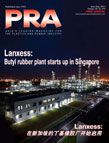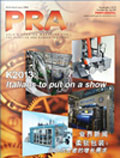Sipa leads breakthrough design in dispenser bottle

Large PET dispenser bottles are an excellent means of storing and dispensing water in the office and in the home, considering that they are much lighter than traditional glass versions, which weigh close to 20 kg in their five-gallon versions, says Italian specialist in plastic container manufacturing and filling, SIPA.

A regular multi-trip PET dispenser bottle—sometime also called a water cooler bottle, when it sits on a dispensing unit that has a refrigeration system incorporated into it—weighs around 650 g by contrast.
A recent trend has been to use single-use PET dispenser bottles, which weigh even less, at a minimum weight of 330 g. This saves on materials of course, as well as on transport costs. But the bottles still take up a lot of space. The best type of single-use bottle is one that collapses on itself as the water is consumed, ending up as a fat disc that takes up much less room than the original.
FEM analysis

But that is easier said than done. Bottles often collapse in an irregular manner, leaving lots of space inside even when they are completely empty of water. So SIPA has been putting a lot of effort, together with various customers, into developing designs for large PET dispenser bottles that are fit for purpose in transport and use, and which collapse on themselves as neatly as possible as they empty.
Collapsing sequences were simulated on computer using Finite Element Method (FEM) analysis to find the buckling mechanism that would best suit the client’s requirement. “FEM analysis accelerates the time of investigation and reduces the number of trials aiming at the correct solution,” says Dino Zanette at SIPA. “It also aids in determining a minimum weight at which the collapsing mechanism is still functional.

Square and round designs
Different bottle shapes, square and round, were analysed along with the shape of the ribs and base. Graphs of volume vs pressure, and base centre displacement vs pressure, together with photograms of the simulation, helped experts from SIPA to better understand the collapsing phenomena and how to modify the bottle structure to get the best performance. Physical prototypes were built to verify the “virtual” results.
Trials have proven the reproducibility of the collapsing mechanism that was studied during the development stages. So now, fully self-collapsible containers that require the application of no external mechanical forces to deflate are in industrial production. This makes the job of collecting them for recycling or simply putting them in a recycling bin much easier than before, concludes SIPA.
(PRA)Copyright (c) 2015 www.plasticsandrubberasia.com. All rights reserved.









































